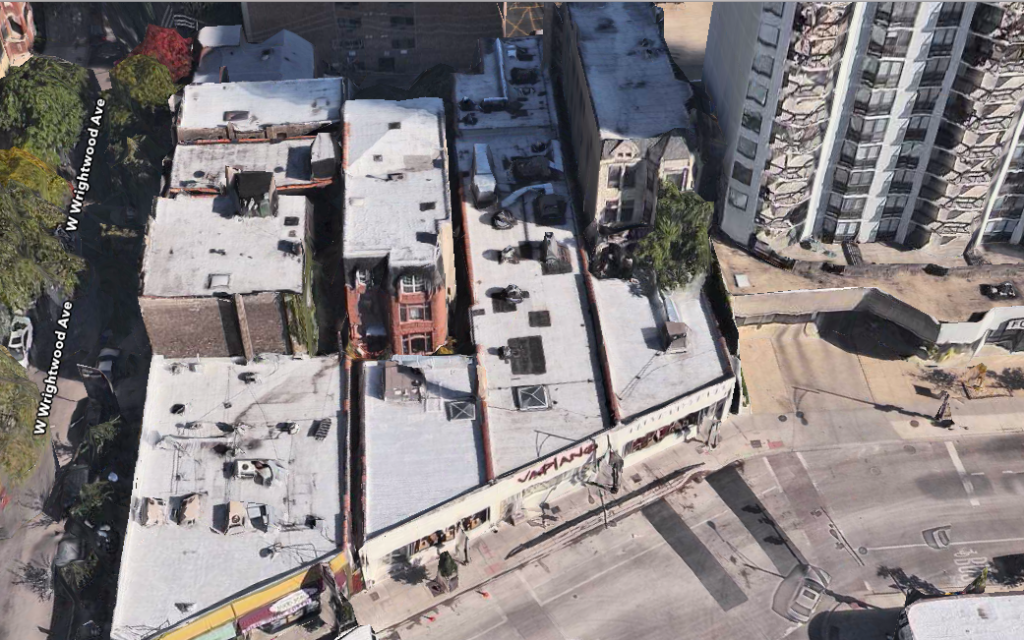How Everything Learns
In 1995 Stewart Brand wrote a book and TV series titled How Buildings Learn, about the evolution of the built environment. Everything has some type of evolution in terms of how it is transformed or replaced over time.
Cities such as Chicago and Paris were almost completely rebuilt. Sometimes the process of bringing something to a resolution leaves many things unresolved, that are subsequently transformed at opportune moments. Like songs and books, architecture and cites can get "rewrites".
It is interesting to study aerial views to see how the fabric of cities gets "mended" from original grids. (See Shearing Layers )
This is a development on north Clark street in Chicago. Clark is a diagonal street running northwest from the city, with a slight jog at this location. It is apparent that the older buildings represent the original street grid, with the subsequent developments of strip retail and a condo building a filling-in of missing teeth.
See: What’s the Deal With the Stranded Buildings on North Clark?
Buildings are frequently re-purposed, such that a vacant store can quickly be reprogrammed into something else. Dead malls will eventually be reprogrammed, or be torn down, leaving only raw building materials.
The old main post office in Chicago is still vacant. After many failed proposals, it might be wise to raze it and build new structures from the components. The reuse of materials preserves the memory of a building, as well as parts of cities that no longer exist in their original state.
Hundreds of years in the future we will refer to it with its legacy term "The Post Office", when most people won't even know that such a thing ever existed, and left to piece together the history, similar to the Clark street "stranded buildings" situation.
Individual buildings and districts can be restored, but in the Theseus Paradox, the simulant is not the same object.
Entropy of the skyscraper
Newer cities such as Dubai will begin to disintegrate and be upgraded in the same way. It is an organic process, similar to insect nests that patch in pieces that have fallen away. Nothing is left "unbroken", even if there is no way to return it to its original shape. This has become somewhat of a visual meme in dystopian future films such as Divergent, where destroyed and abandoned cities lie in disrepair, awaiting their rebirth. It is an apt depiction vis-a-vis Chicago's history of reinvention, even if sometimes through a green screen.
Cities such as Chicago and Paris were almost completely rebuilt. Sometimes the process of bringing something to a resolution leaves many things unresolved, that are subsequently transformed at opportune moments. Like songs and books, architecture and cites can get "rewrites".
It is interesting to study aerial views to see how the fabric of cities gets "mended" from original grids. (See Shearing Layers )
This is a development on north Clark street in Chicago. Clark is a diagonal street running northwest from the city, with a slight jog at this location. It is apparent that the older buildings represent the original street grid, with the subsequent developments of strip retail and a condo building a filling-in of missing teeth.
See: What’s the Deal With the Stranded Buildings on North Clark?
Buildings are frequently re-purposed, such that a vacant store can quickly be reprogrammed into something else. Dead malls will eventually be reprogrammed, or be torn down, leaving only raw building materials.
The old main post office in Chicago is still vacant. After many failed proposals, it might be wise to raze it and build new structures from the components. The reuse of materials preserves the memory of a building, as well as parts of cities that no longer exist in their original state.
Hundreds of years in the future we will refer to it with its legacy term "The Post Office", when most people won't even know that such a thing ever existed, and left to piece together the history, similar to the Clark street "stranded buildings" situation.
Individual buildings and districts can be restored, but in the Theseus Paradox, the simulant is not the same object.
Entropy of the skyscraper
Newer cities such as Dubai will begin to disintegrate and be upgraded in the same way. It is an organic process, similar to insect nests that patch in pieces that have fallen away. Nothing is left "unbroken", even if there is no way to return it to its original shape. This has become somewhat of a visual meme in dystopian future films such as Divergent, where destroyed and abandoned cities lie in disrepair, awaiting their rebirth. It is an apt depiction vis-a-vis Chicago's history of reinvention, even if sometimes through a green screen.


